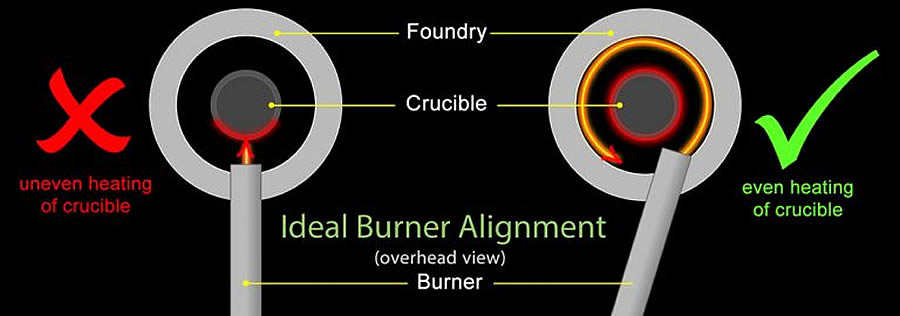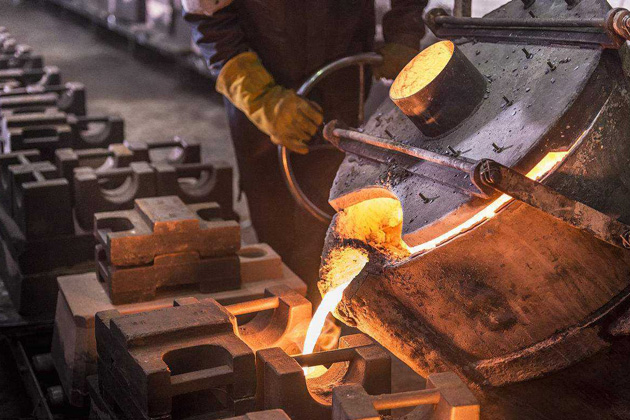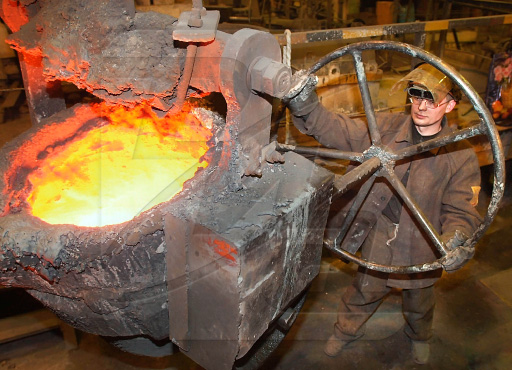Aluminum Foundry Wisconsin stands as a reliable partner in casting solutions
A Comprehensive Overview to the Strategies Used in Aluminum Foundry Operations
Aluminum Foundry procedures utilize numerous casting techniques, each with distinct procedures and applications. Recognizing these methods is important for maximizing production and accomplishing preferred product properties. From sand casting to pass away spreading, the selections readily available can significantly affect performance and cost. As modern technology advances, so too do these methods, prompting a better exam of their limitations and advantages. The effects of these developments necessitate further expedition.
Introduction of Aluminum Casting Techniques
Aluminum spreading techniques encompass a range of methods utilized to shape liquified Aluminum right into preferred kinds. These techniques are crucial in the production and engineering markets, supplying versatility and performance. Significant methods include die spreading, which utilizes high-pressure to inject Aluminum into mold and mildews for accuracy parts, and gravity casting, where molten Aluminum is poured right into mold and mildews intoxicated of gravity, enabling for bigger, less complex forms. Financial investment spreading, an additional method, involves developing a wax pattern covered in ceramic, offering high dimensional precision for elaborate layouts. Furthermore, long-term mold and mildew spreading makes use of multiple-use mold and mildews, improving manufacturing effectiveness and minimizing waste. Each method caters to details applications, balancing variables such as price, production quantity, and material buildings. As industries develop, innovations in these casting techniques continue to improve the high quality and efficiency of Aluminum elements, positioning them as necessary procedures within contemporary production.
Sand Spreading: Refine and Applications
Sand spreading is a widely made use of technique in the Foundry industry, understood for its simplicity and adaptability. Aluminum Foundry. This procedure entails producing a mold and mildew from a blend of sand and a bonding agent, usually clay. The mold and mildew is formed around a pattern, which is a replica of the desired last product. When the mold is prepared, molten Aluminum is poured into the tooth cavity, enabling it to strengthen right into the desired form
One of the main benefits of sand spreading is its capacity to create large components and intricate geometries, making it appropriate for numerous applications, consisting of auto components, equipment parts, and attractive things. Additionally, sand spreading can fit various Aluminum alloys, enhancing its adaptability. The procedure is economical for low to tool production runs, as it does not call for expensive tooling. On the whole, sand casting continues to be a basic method in Aluminum Foundry operations as a result of its effectiveness in conference varied manufacturing demands.
Pass Away Spreading: Benefits and Limitations
While die casting is frequently contrasted to sand casting, it uses unique advantages and constraints that make it appropriate for certain applications in the Aluminum Foundry industry. One significant benefit of die spreading is its capacity to generate complex shapes with high dimensional precision and exceptional surface coating. This process is particularly beneficial for mass production, as it permits faster cycle times and decreased labor prices. Additionally, pass away casting reduces material waste, boosting general effectiveness.
Die casting additionally has restrictions. The first tooling expenses are fairly high, making it much less practical for little manufacturing runs. Moreover, the process is finest fit for steels with reduced melting factors, which can restrict product options. Pass away spreading is additionally minimal regarding the optimum dimension of the components produced, as bigger components may need alternate methods. Balancing these variables is vital for determining the ideal application of die casting in the Aluminum Foundry field.
Financial Investment Spreading: Accuracy and Detail
Investment spreading is a very specific manufacturing process that permits for detailed styles and great details in Aluminum elements. This technique uses substantial advantages, consisting of boosted dimensional precision and reduced machining needs. Its applications span various sectors, highlighting its versatility and efficiency in generating complex parts.
Refine Review
The investment casting process is renowned for its capability to create high-precision components and complex shapes. This technique starts with creating a wax pattern, which is after that covered with a ceramic covering. As soon as the shell solidifies, the wax is disappeared, leaving an accurate cavity for the liquified steel. The Aluminum is poured right into this tooth cavity, catching the great information of the original pattern. After cooling down, the ceramic shell is escaped, disclosing the actors component. Any kind of required finishing job, such as machining or surface area treatment, is performed to attain the wanted requirements. This process is particularly helpful for intricate geometries that are difficult to attain through typical casting strategies, making sure both high quality and accuracy in the end product.
Benefits of Accuracy
Accuracy in financial investment spreading uses substantial advantages, making it a favored selection for producing complex components. This strategy allows the production of detailed forms with limited resistances, minimizing the requirement for considerable machining and lessening material waste. The ability to achieve high dimensional accuracy equates to a remarkable fit and surface, boosting the overall high quality of the last product. In addition, investment casting enables the consolidation of great information, which is vital for parts requiring complex styles. The procedure likewise sustains making use of various Aluminum alloys, additionally broadening its applicability. Generally, the accuracy offered by financial investment casting not just enhances the practical and aesthetic qualities of parts yet additionally adds to improved efficiency in production cycles.
Applications in Market
While many manufacturing procedures exist, financial investment spreading attracts attention for its flexibility throughout various markets, especially in sectors demanding high accuracy and thorough components. This spreading approach is commonly utilized in aerospace, automobile, and clinical areas, where detailed styles and tight tolerances are necessary. As an example, aerospace components gain from investment casting's capacity to create complicated geometries that decrease weight without compromising architectural stability. In a similar way, the automotive industry utilizes this strategy to produce engine parts that call for resilience and precision. In the clinical sector, financial investment casting enables the production of medical instruments and implants that have to fulfill stringent high quality standards. On the whole, investment spreading considerably boosts item efficiency and reliability, making it a vital strategy in modern manufacturing applications.
Contrast of Casting Approaches
 The comparison of casting methods discloses unique benefits and applications throughout different techniques - Aluminum Foundry. Sand spreading is often celebrated for its adaptability and cost-effectiveness, while die spreading is recognized for its performance and accuracy in producing high quantities. Investment casting, previously reviewed, showcases its special capability to produce detailed designs, further emphasizing the diverse abilities of each method in Aluminum Foundry operations
The comparison of casting methods discloses unique benefits and applications throughout different techniques - Aluminum Foundry. Sand spreading is often celebrated for its adaptability and cost-effectiveness, while die spreading is recognized for its performance and accuracy in producing high quantities. Investment casting, previously reviewed, showcases its special capability to produce detailed designs, further emphasizing the diverse abilities of each method in Aluminum Foundry operationsSand Spreading Advantages
Sand casting provides several benefits when contrasted to other casting techniques, making it a preferred option in various manufacturing applications. One of the key benefits is its low price, as the products needed, such as sand and steel, are cost-effective and easily available. Additionally, sand casting permits for greater design flexibility, enabling the manufacturing of intricate shapes and large elements that may be challenging to accomplish with other techniques. The procedure also suits a vast array of steel alloys, consisting of Aluminum, improving its convenience. Sand mold and mildews can be quickly repaired or modified for subsequent casts, making it effective for both tiny and large production runs. Overall, these benefits add to sand spreading's popularity in the Foundry sector.
Die Casting Techniques
Die spreading methods stand out as a highly efficient approach for producing metal parts, particularly when contrasted to typical spreading methods like sand casting. This procedure involves compeling liquified Aluminum into a mold under high pressure, leading to precise measurements and a smooth surface area coating. Unlike sand casting, which requires considerable finishing job, pass away casting lessens post-production processing, enhancing general efficiency. Additionally, pass away spreading can suit complex geometries, permitting detailed designs that would be testing to attain with various other approaches. The speed of manufacturing is one more benefit; pass away spreading can produce large amounts of components in a shorter duration. Generally, the combination of style, precision, and efficiency flexibility makes pass away casting a preferred selection in modern-day Aluminum Foundry operations.
Investment Casting Applications
Investment casting, commonly referred to as lost-wax spreading, provides unique benefits over other casting approaches, especially with respect to precision and surface area coating. This technique enables the production of elaborate forms and fine details that are tough to achieve with sand or die spreading. Additionally, financial investment spreading creates elements with premium dimensional precision, lowering the need for comprehensive machining. Its versatility makes it appropriate for different sectors, consisting of aerospace, vehicle, and clinical gadgets, where top notch components are essential. Contrasted to die spreading, which can be limited by mold and mildew intricacy, investment spreading masters producing complicated geometries without compromising architectural stability. Subsequently, the option of financial investment casting comes to be progressively desirable for applications demanding high Get More Information efficiency and integrity.
Quality Assurance in Aluminum Foundry Operations
Exactly how can Aluminum shops assure the best quality in their products? Executing rigorous quality assurance steps is necessary. Foundries usually start by developing clear specs for the Aluminum alloys utilized, ensuring they fulfill sector standards. Continuous tracking throughout the melting and pouring processes aids determine any inconsistencies from wanted chemical structures.
Moreover, visual assessments and non-destructive screening techniques, such as ultrasonic or X-ray evaluations, are generally employed to spot interior flaws or variances in spreadings. Additionally, analytical procedure control methods track production information, enabling for early identification of prospective concerns.
Normal training and accreditation of employees in top quality guarantee techniques are essential for keeping high requirements. Implementing comments loopholes from consumers can aid shops refine their More Bonuses processes and boost item high quality. By adhering to these techniques, Aluminum shops can regularly provide top notch items that exceed or fulfill consumer assumptions.
Future Fads in Aluminum Spreading Technology
Developments in Aluminum spreading innovation are positioned to reshape the sector landscape, structure upon well-known quality assurance techniques. Developments such as additive manufacturing and wise Foundry options are arising, making it possible for improved style adaptability and lowered waste. The combination of expert system and artificial intelligence in process monitoring enables real-time modifications, boosting performance and item high quality.
Sustainability remains a crucial focus, with a focus on recycling scrap Aluminum and lowering power intake. Advanced alloy formulations are being established to maximize efficiency while reducing environmental impact. The adoption of automated systems, including robotics for pouring and handling, assures to improve office safety and precision.
Furthermore, digital doubles are obtaining grip, permitting online simulations that facilitate better decision-making and anticipating maintenance. As these fads progress, they will likely create an extra reliable, sustainable, and highly advanced Aluminum casting industry, establishing brand-new criteria for high quality and performance.
Frequently Asked Inquiries
What Precaution Should Be Absorbed Aluminum Foundry Operations?
In Aluminum Foundry operations, vital safety actions include personal safety devices, correct ventilation, routine training, danger analyses, emergency preparedness, and adherence to procedures to mitigate threats related to liquified steel and hefty machinery.
How Is Recycled Aluminum Used in Foundry Processes?
Recycled Aluminum is typically utilized in Foundry procedures to decrease environmental impact and production costs. It undergoes melting and refining, permitting producers to develop high-grade products while conserving energy and minimizing waste in the Aluminum lifecycle.
What Devices Is Crucial for Aluminum Spreading?
Vital tools for Aluminum casting consists of furnaces for melting, molds for shaping, putting ladles, cooling systems, and finishing devices. Each part plays an important function in ensuring the effectiveness and high quality of the spreading procedure.
Exactly How Do Ecological Rules Influence Aluminum Foundries?
Environmental guidelines considerably impact Aluminum factories by enforcing limits on emissions and waste monitoring. Conformity needs financial investment in cleaner innovations, which can enhance operational expenses yet eventually promotes sustainability and reduces the ecological footprint of the market.

What Are Typical Flaws in Aluminum Castings and Their Solutions?
Typical issues in Aluminum castings consist of shrinkage, porosity, and surface area imperfections. Solutions include maximizing thaw quality, managing air conditioning prices, and employing appropriate mold layout, ensuring pop over here much better honesty and performance of the final cast products.
 Major methods consist of die spreading, which employs high-pressure to inject Aluminum into molds for precision components, and gravity casting, where liquified Aluminum is poured into mold and mildews under the impact of gravity, allowing for bigger, much less intricate shapes. While die spreading is usually contrasted to sand casting, it supplies distinct advantages and constraints that make it ideal for particular applications in the Aluminum Foundry sector. Sand spreading is usually celebrated for its versatility and cost-effectiveness, while die spreading is recognized for its effectiveness and accuracy in generating high volumes. Pass away casting methods stand out as a very efficient method for producing steel parts, especially when contrasted to typical casting approaches like sand casting. Contrasted to pass away spreading, which can be limited by mold and mildew intricacy, investment casting excels in generating intricate geometries without compromising structural honesty.
Major methods consist of die spreading, which employs high-pressure to inject Aluminum into molds for precision components, and gravity casting, where liquified Aluminum is poured into mold and mildews under the impact of gravity, allowing for bigger, much less intricate shapes. While die spreading is usually contrasted to sand casting, it supplies distinct advantages and constraints that make it ideal for particular applications in the Aluminum Foundry sector. Sand spreading is usually celebrated for its versatility and cost-effectiveness, while die spreading is recognized for its effectiveness and accuracy in generating high volumes. Pass away casting methods stand out as a very efficient method for producing steel parts, especially when contrasted to typical casting approaches like sand casting. Contrasted to pass away spreading, which can be limited by mold and mildew intricacy, investment casting excels in generating intricate geometries without compromising structural honesty.